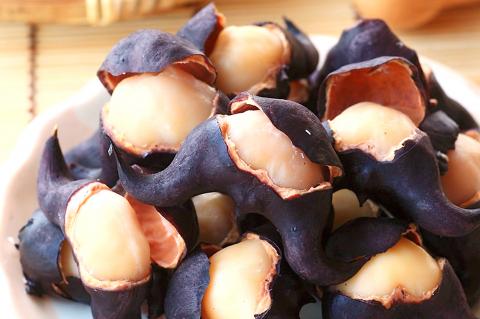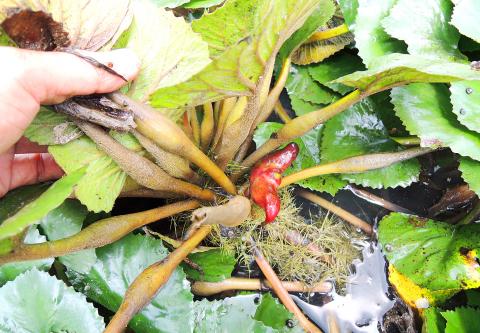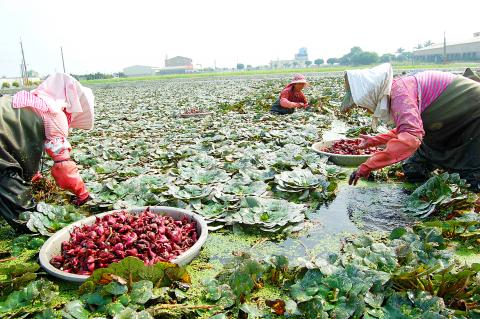Water caltrops look like devil’s horns. They look like bats on the wing. Their horn-like shape has earned them the nicknames “Devil’s pod” or “buffalo nuts,” and they are sometimes called “water chestnuts” due to their taste. They are now in season.
Most of the water caltrops in Taiwan are grown in Tainan’s Guantian District. This area has about 380 hectares of farmland in which to grow the crop, and you can see large water caltrop fields everywhere, with stalls selling just-boiled devil’s pods along the roads. Visitors to this year’s Guantian Water Caltrop Festival were surprised to learn that the buffalo nuts actually grow in water.
The roots of the water caltrop plants extend down into the soil, and their stems break the surface of the water, with triangular leaves floating on the surface. They can be harvested from mid-September to November each year. Most of water caltrop farmers in Taiwan start growing the crop in May, after they have brought in the first rice harvest.

Photo: Lee Chieh-pin and Wang Mei-chun , Liberty Times
照片:自由時報記者李价斌、王美春
Water caltrops grow best in hot, humid climates with plenty of sunshine. As they bear fruit in temperatures of between 25 and 36 degrees Celsius, they thrive in southern Taiwan, and are grown predominantly in Tainan’s Guantian District and Kaohsiung’s Renwu District.
The flesh of water caltrops is delicious and nutritious, its taste somewhat reminiscent of chestnuts. Devil’s pods can be eaten boiled or used in cooking, such as in buffalo nut and pork rib soup and three-cup chicken with water caltrops, to name but a few popular dishes.
(Liberty Times, translated by Lin Lee-kai)

Photo: Yang Chin-cheng, Liberty Times
照片:自由時報記者楊金城
菱角外型近似魔鬼頭上的角,或飛翔的蝙蝠。因其外觀及味道,英文稱之為「魔鬼莢」、「水牛果」或「水栗」。而現在正是菱角的產季。
台南市官田區是全台最大的菱角產地,種植面積約三八○公頃,處處可見大片的菱田,路旁有許多熱騰騰的水煮菱角攤。官田菱角季日前登場,讓遊客大開眼界,驚呼「原來菱角長在水裡!」
菱角的根生於土中,水中莖長達水面,三角形葉浮生於水面,每年九月中至十一月為盛產期。台灣大多數菱農是在一期作稻米收割完後的五月間才開始種植。

Photo: Yang Chin-cheng, Liberty Times
照片:自由時報記者楊金城
菱角性喜高溫、多日照、多濕的氣候環境,結果實的適溫為攝氏二十五至三十六度,因此產區多在南台灣,目前以台南官田、高雄仁武為主要種植區域。
菱角富含營養、肉質鮮美,吃進嘴裡有宛若栗子的香味。除了水煮菱角外也可入菜,常見的料理方式有菱角排骨湯、三杯菱角雞等。
(自由時報)

In most cities, food waste is often regarded as one of the most troublesome types of waste: it has a high moisture content, spoils easily and produces strong odors. If not handled properly, it can cause serious sanitation and environmental problems. From the perspective of the circular economy, however, food waste is not “useless leftovers,” but rather an organic resource that has yet to be effectively utilized. The core principle of the circular economy is to break away from the linear model of “production–consumption–disposal,” allowing resources to circulate repeatedly within a system and extending their useful life. Food waste occupies a

Just like fingerprints, your breathing patterns may serve as a definitive identifier. In a recent study, scientists have demonstrated an astonishing 96.8% accuracy in identifying individuals based on their respiratory patterns. This revelation could open up new possibilities in biometrics and personalized health monitoring. The notion of using individual breathing patterns as a distinct biological signature has long been a topic of discussion within the respiratory science community, yet a practical method for measurement remained elusive. This changed with the invention of a tiny, wearable device capable of extended recording. Researchers deployed a lightweight tube designed to fit inside

In June, headlines shocked the art world when a visitor damaged a 17th-century painting at the Uffizi Galleries in Florence, Italy, while posing for a photograph. This was not an isolated event. Recently, similar disasters have been reported worldwide, from a child damaging a Mark Rothko painting to a tourist breaking an exhibit by pretending to sit on it. Such incidents highlight why museum etiquette is increasingly crucial. First, we must recognize that art and historical objects are fragile. Once damaged, they may never regain their original condition. Many common actions, though harmless at first glance, can have grave consequences. For

Continued from yesterday(延續自昨日) The study also uncovered a correlation between breathing patterns and mental well-being. Participants with higher scores on anxiety questionnaires exhibited shorter inhalation periods and more frequent breath pauses during sleep. “We intuitively assume that how depressed or anxious you are changes the way you breathe,” says one researcher involved in the study. “But it might be the other way around.” If this proves true, then training people to adjust their breathing may offer a novel approach to managing conditions like anxiety or depression. 該項研究也揭露了呼吸模式與心理健康之間的關聯。在焦慮問卷得分較高的受試者於睡眠期間表現出的吸氣時間較為短促、呼吸中止更為頻繁。一位參與研究的學者表示:「我們直覺地認為憂鬱或焦慮的程度會改變你的呼吸方式,但有可能是反過來的情況。」如果這一假設得到證實,那麼訓練人們調整呼吸的方式,可能會成為管理焦慮或憂鬱等疾病的新穎方法。 What Did You Learn? 1. What problem did scientists previously face when trying to measure breathing patterns? 2.